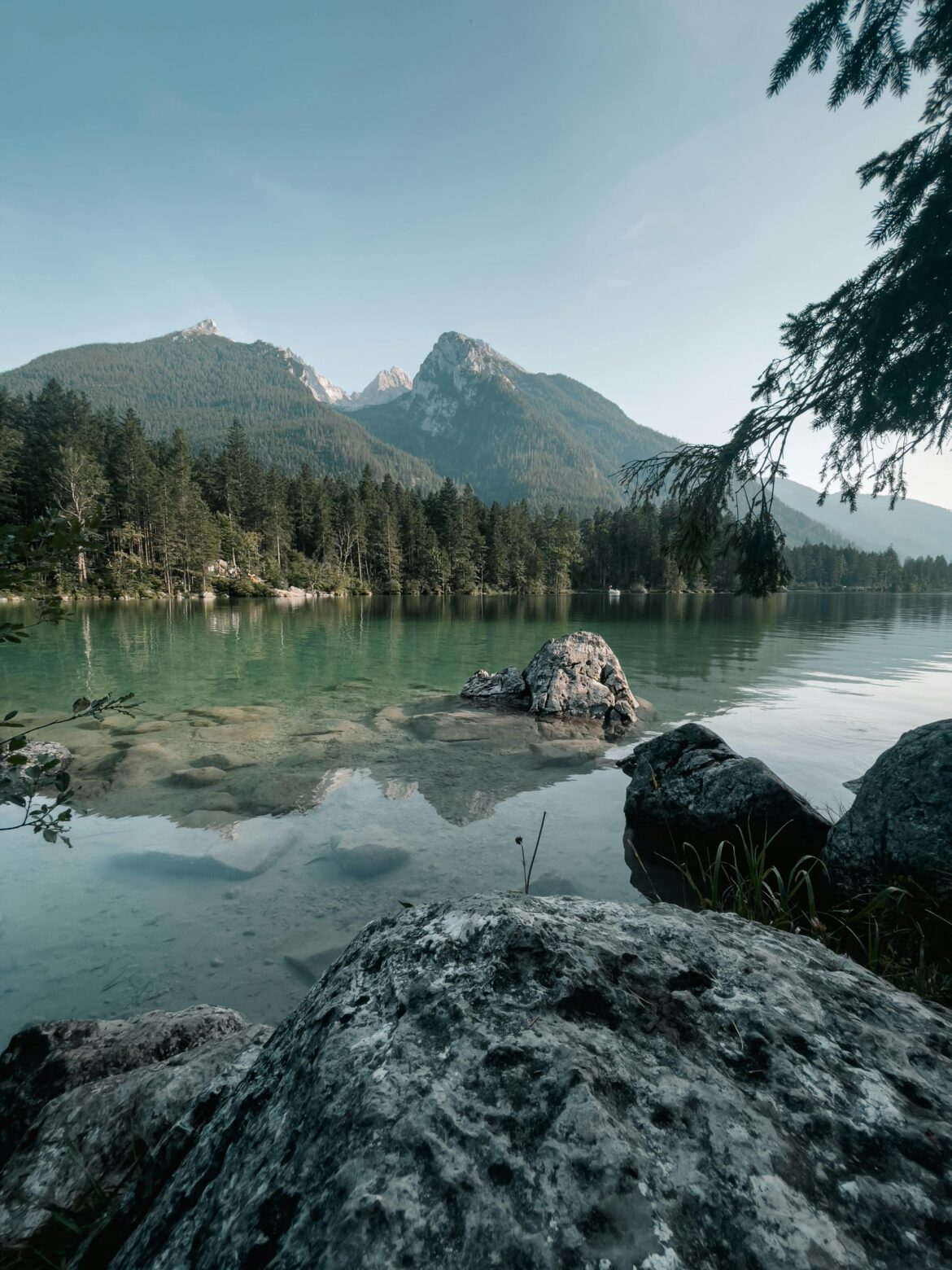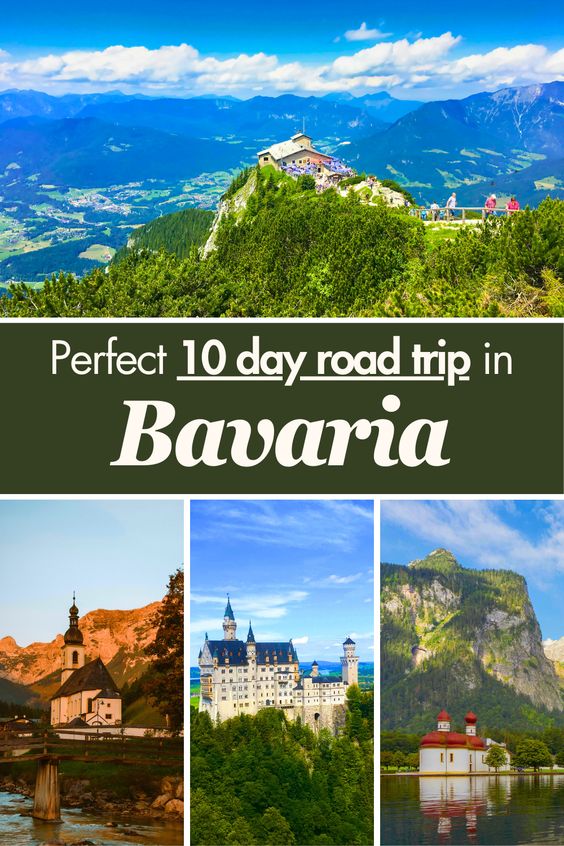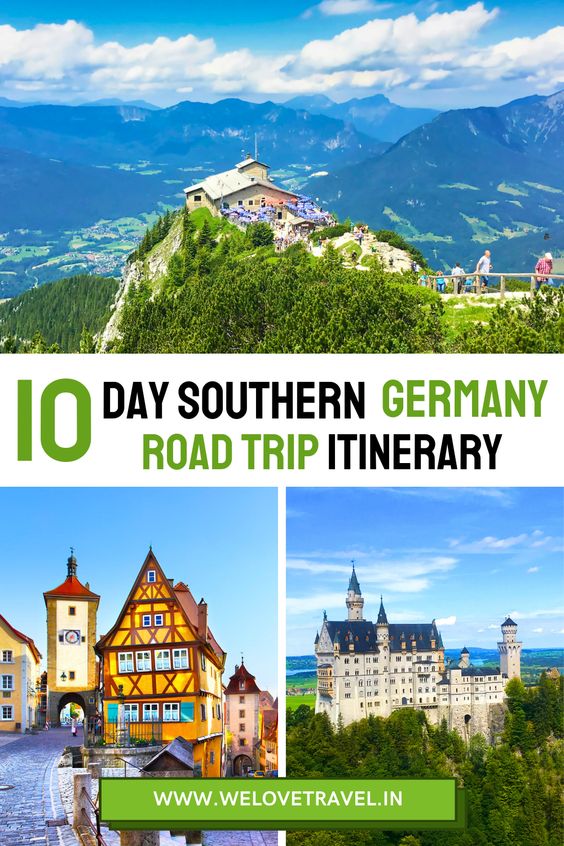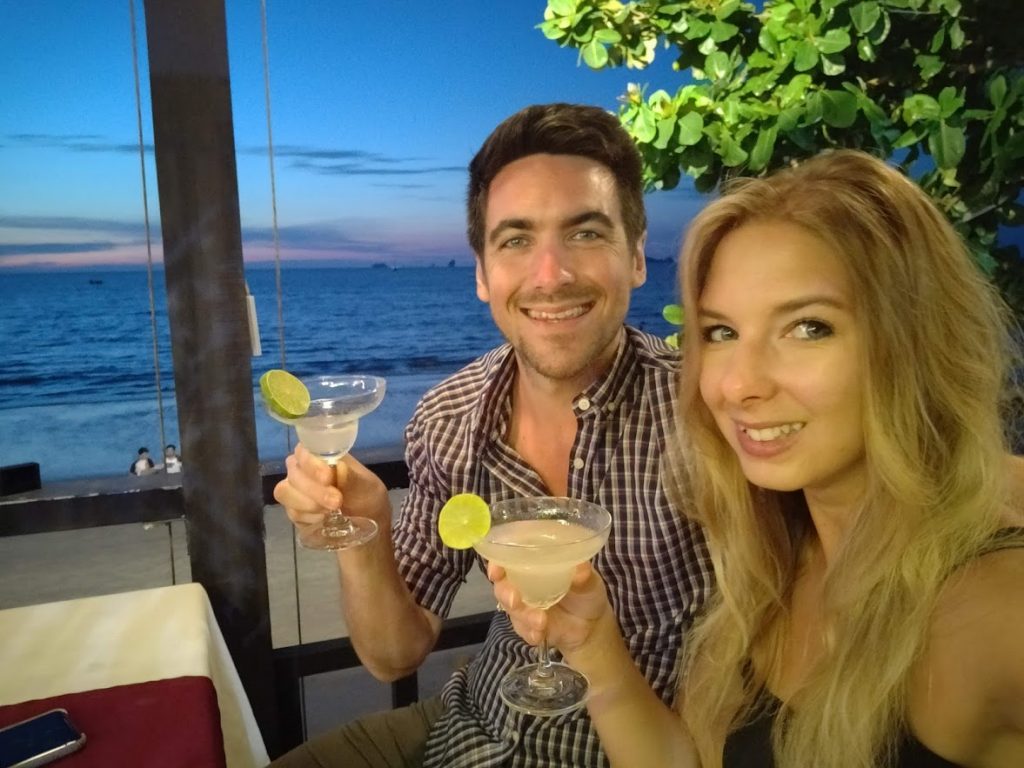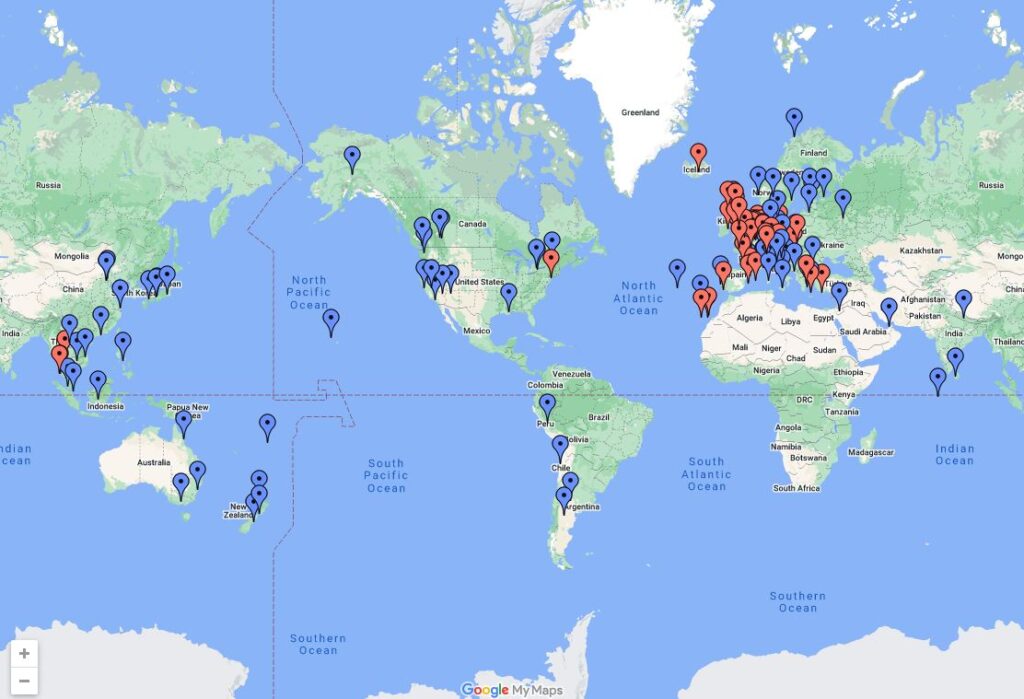Here is your ultimate 10 day Germany road trip itinerary across Bavaria – arguably one of Germany’s most beautiful regions. But what does a Bavaria road trip itinerary offer? Imagine winding mountain passes, deep green forests, fairytale castles perched among the mountains, small mountain villages, cow bells ringing through the hills, and mirror-finish emerald lakes. Bavaria is a stunning part of Germany with so much to offer, you could easily spend 10 months exploring this part of the country! But this 10 day Bavaria itinerary covers some of the region’s top sights and highlights – perfect if this is your first-time here.
Where is Bavaria?
Bavaria is a state in southeast Germany, bordering Austria and Czech-Republic and includes the mountain range of the Bavarian Alps. In the summer the region’s rolling hills are filled with luscious green hills, while in the winter, the snow covered mountains make for a magical winter getaway.
Why should you visit Bavaria?
If you haven’t visited before, Bavaria may not seem like an immediately obvious choice, compared to tourist hotspots like Berlin, Hamburg or Frankfurt. Munich is another popular choice, but did you know Munich is actually part of Bavaria? With an area of 27,239.58 sq mi, Bavaria is the largest German state, comprising roughly a fifth of the total land area of Germany! So it’s likely many of your bucket list sights in Germany will be in Bavaria!
You can drink German beer during Oktoberfest. Visit Neuschwanstein Castle (the inspiration for Disney’s Cinderella Castle). Climb Zugspitze the highest peak in Germany. Witness local traditions (and lots of lederhosen). Or learn about WWII history by visiting Hitler’s Eagle’s Nest in Berchtesgaden – and that’s just for starters!
Overview: 10 Day Germany Road Trip Itinerary in Bavaria
First up, this Bavaria itinerary assumes you have a car. Although you can travel around Bavaria via public transport, having your own car will give you much more flexibility and allow you to fit more into the time that you have.
When we did our road trip around Southern Germany, we took our own car onto the Channel Tunnel and drove from Calais into Germany. For ease, this itinerary is based on a flight into Munich with a hire car. You can however cut and shape this plan into anyway that suits you best, depending on your travel plans. There are also a couple of optional extras thrown in, which can extend this into a 12 or 14 day trip.
- Day 1: Fly into Munich, pick-up your hire car and drive straight to Rothenburg ob der Tauber
- Day 2: Drive to Füssen
- Day 3: Visit Neuschwanstein Castle
- Day 4: Drive to Berchtesgaden, via Zugspitze
(Optional: Stay overnight at Garmisch-Partenkirchen) - Day 5: Berchtesgaden
- Day 6: Berchtesgaden
- Day 7: Drive to Munich, via Salzburg
- Day 8: Munich
- Day 9: Munich
(Optional: Spend an extra night in Munich and visit Dachau Concentration Camp) - Day 10: Final day in Munich and fly home
This plan is loosely based on the Germany road trip itinerary we took during our trip (although in a slightly different order). We have a full write-up of our road trip, which you can read here.
The Start of Your Bavaria Itinerary
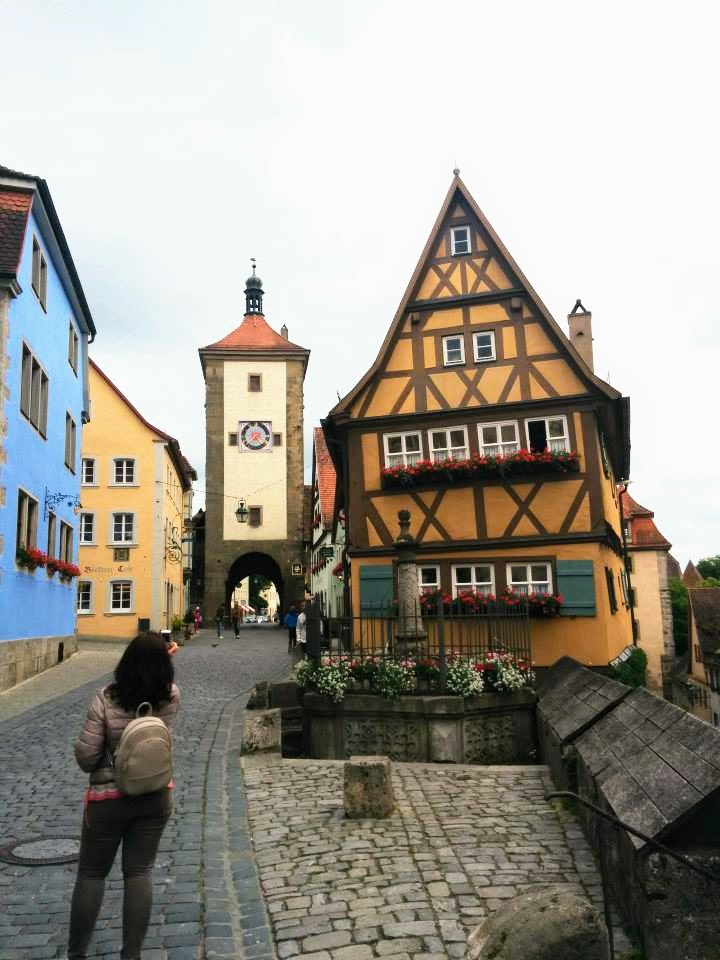
Day 1 – Munich to Rothenburg ob Tauber
Drive time: 2 hours 40 minutes
Distance: 154 miles (255km)
Rothenburg ob Tauber is a small town in Northern Bavaria. It’s known for being one of Germany’s best preserved medieval walled towns, and when we say “small”, we mean it. The town has a population of roughly 11,000 and is only 16sq miles. But with its picture-perfect half-timbered buildings, scenic cobblestone streets and frozen-in-time towers and gatehouses, Rothenburg is super picturesque and is the ideal start to your Germany road trip.
Things to see & do in Rothenburg
- Plönlein & Siebers Tower (see above photo).
- Walk the Town Walls
- Visit St Jakobskirche
- Spital Bastion
- Explore Marktplatz
- Visit the Christmas shop
- Eat Schneeballen
Rothenburg may be small, but it packs a punch! You can fill your time as much or as little as you want, with tours and museums throughout the town. Or you can spend your time exploring the scenic streets and enjoying a slower pace. Either way, there is something for everyone here.
Around the perimeter of Rothenburg are the town’s old medieval walls, which used to protect the town. The walls are completely intact and you can walk the whole 1.5 mile route. The route also includes 42 towers and 6 gatehouses, providing stunning views over the top of Rothenburg’s rooftops.
There is also a Christmas Shop, which is open year-round, providing the best opportunity for a nice souvenir or two. Or you can explore the main town square (Marktplatz). Filled with cafes, restaurants and wine bars, where you can sit back, people watch, and enjoy what this lovely little town has to offer.
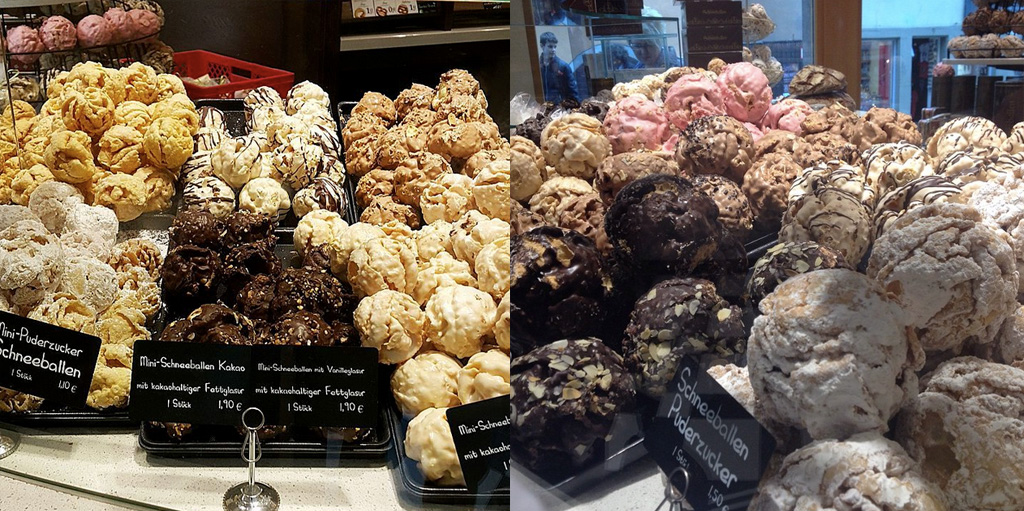
Rothenburg is not just famous for its medieval architecture, but also for the delicious sweet treat, Schneeballen (or “snowballs”). These are off-cut strips of pastry, rolled up into a ball, and coated in a variety of different sweet toppings. I won’t even begin to list the number of toppings available – if you can think of a flavour, chances are you can order it! But if you like to keep things simple, you can also order just good ole icing sugar.
Day 2 – Rothenburg to Füssen (via the Romantic Road)
Drive time: 4 hours 20 minutes
Distance: 179 miles (288km)
For day 2 of your Germany road trip itinerary you can either spend a bit more time exploring Rothenburg, or head straight off, hitting the road South, towards Füssen. This route will take you along The Romantic Road.
What is The Romantic Road?
The Romantic Road (Romantische Straße) is a picturesque route, spanning 217 miles (350km) from Würzburg in the North, down to Füssen. Picking up the route from Rothenburg does mean you miss about 40/50 miles, but this is a long route, so you will still drive the vast majority of it anyway.
The scenic route twists and turns through some of Bavaria’s most picture-perfect fairytale towns. You can of course stop off and explore any of the towns you want, but that could easily turn into a 2 week holiday in itself! This isn’t massively necessary though and you can still enjoy the beauty of the route as you pass through each town on your way to Füssen.
The route is easy to plan – there are brown tourist signs with “Romantische Straße” along the whole route. Alternatively, you can add each of the towns as a waypoint into Google Maps and let the sat nav guide you from point to point. There is a map below of each of the towns you’ll pass through along the Romantic Road.
Germany Road Trip Itinerary: Driving the Romantic Road
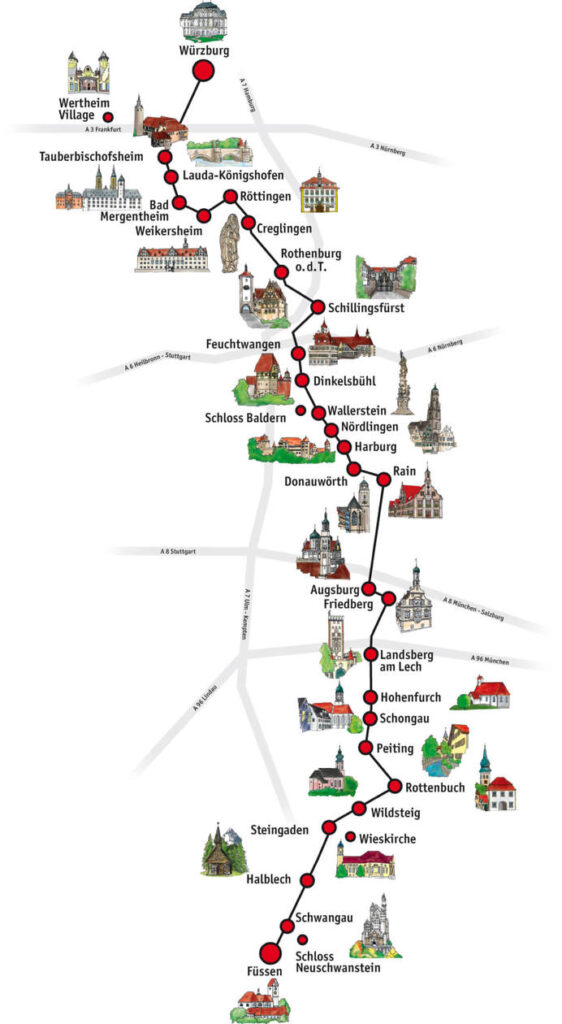
A highlight for your Bavaria itinerary and a great opportunity to experience German roads at their finest! This route makes for a superb part of your road trip experience, and is the chance to tick off one of Germany’s most famous driving routes.
During our road trip, we approached from the opposite direction. We stayed an hour away, in Oberstdorf, by the Austrian border, as we drove in from The Black Forest via Zurich. The purpose of adding Füssen as your overnight stop is that it’s an ideal base for tomorrow’s day of exploring the world famous Neuschwanstein Castle.
Day 3 – Neuschwanstein Castle
Drive time: 6 minutes
Distance: 2.3 miles (3.6km)
An iconic moment during your Bavaria itinerary. Perched on a rugged hilltop, overlooking the Pöllat Gorge and set against the backdrop of the Bavarian Alps, Neuschwanstein Castle is truly a one-of-a-kind masterpiece, plucked straight from the pages of a fairytale. It was this very castle that inspired our whole Germany road trip itinerary!
Said to have been the inspiration for Walt Disney’s Sleeping Beauty Castle, Neuschwanstein has become one of the region’s (if not the country’s) biggest attractions – and it’s easy to see why!
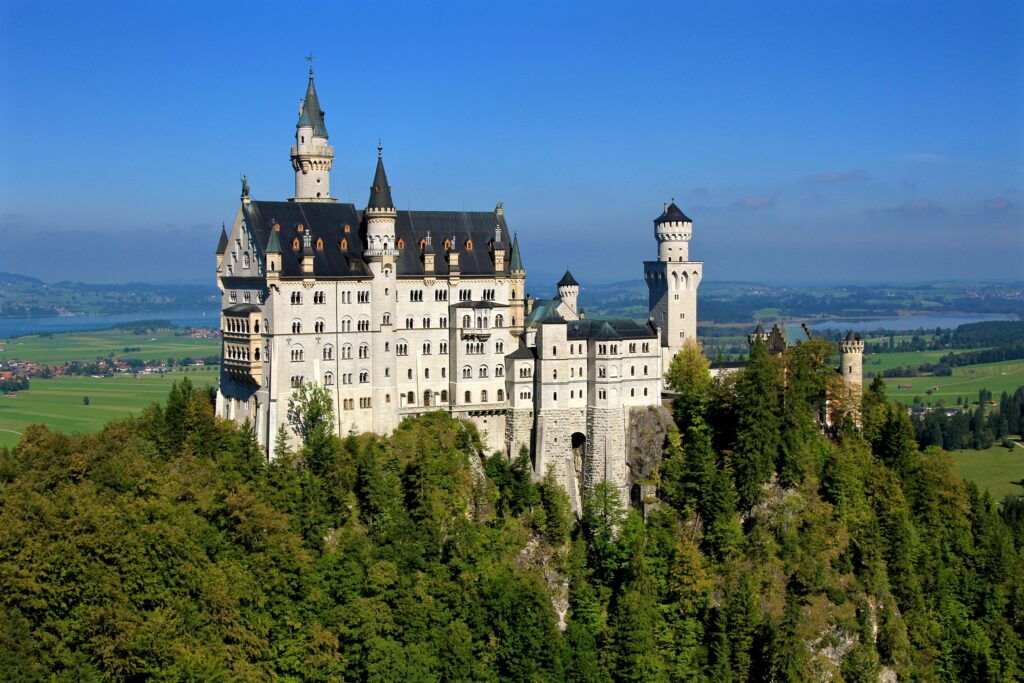
Things to know before you visit
- It gets very busy, particularly in the peak season from late-June to early-September. It’s said that the castle can be visited by up to 6,000 tourists in one day!
- Weekdays, first-thing in the morning (pre-8am) are your best times for arriving in the area.
- There are no driving routes or car parks directly outside the castle. You will need to park up below the castle in Hohenschwangau, and walk 30 – 40 minutes up a steep hill to the foot of the castle. There is a also a shuttlebus, but even this still drops you 15 minutes walk away from the castle.
- You can’t explore inside the castle unless you have booked a guided tour. The tour lasts for 30 minutes and you can either buy your tickets in advance online (recommended), or from the Hohenschwangau Ticket Centre on the day. However this is on a first-come-first-served basis, and the queue can get insanely long!
- The castle is still incomplete, with only 15 finished rooms! So you won’t be able to explore the full extent of the building.
- Make sure you take in the views from Marienbrücke (Mary’s Bridge) to get those iconic shots of the castle.
We have written a complete guide of everything you need to know about visiting Neuschwanstein Castle, including when to visit, and where the best photo spots are.
Things to see & do in the area
- Visit Hohenschwangau Castle
- Explore Alpsee
- Stroll around Schwansee
- Catch the cable car to Tegelberg
While it can be tourist-heavy, this is a truly stunning corner of the German Alps, with so much to see and explore. As you leave the castle, the crowds too start to filter out. A short walk from Neuschwanstein is Hohenschwangau Castle. You can purchase combined tickets which give you entrance to both sites, or you can explore the grounds of the castle for free.
Just behind Hohenschwangau Castle is the beautiful Alpsee, a peaceful lake set at the foot of the surrounding mountains. There are lots of hiking trails or you can enjoy the circular route all around the lake. My personal favourite was the smaller and more tucked away Schwansee, just a short walk from Hohenschwangau itself. We visited in June and had the whole lake to ourselves. The lake also offers gorgeous views of Neuschwanstein Castle from the mountains.
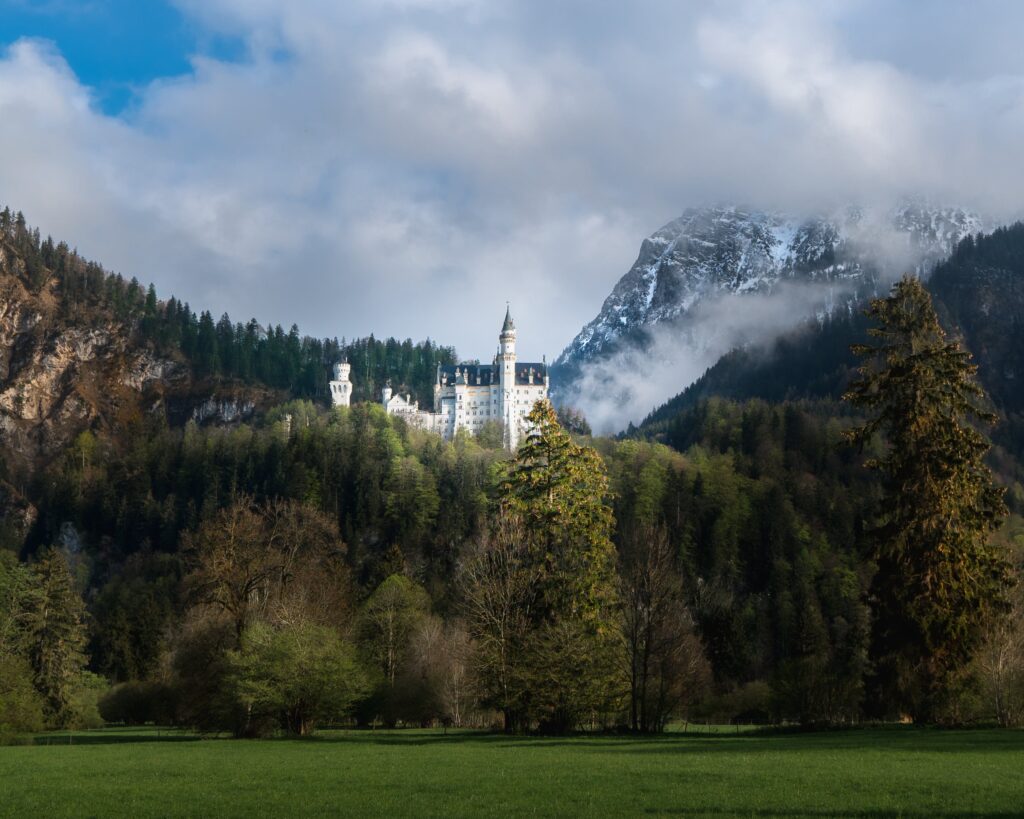
Day 4 – Füssen to Berchtesgaden (via the German Alpine Road)
Drive time: 5 hours 15 minutes
Distance: 195 miles (314km)
Make an early start for an epic day of driving in this Germany road trip itineray! Today you will pick up the German Alpine Road (Deutsche Alpenstrasse) to Berchtesgaden.
The German Alpine Road is the oldest touring road in Germany, dating as far back as 1879. It was first documented by King Maximillian, with many of the sights and attractions he witnessed then remaining largely the same today. The route runs for 280 miles (450km) from Lake Constance, to Lake Königssee in Berchtesgaden. The route is famous for passing stunning lakes, rolling green hills, gorgeous panoramas and dramatic mountains. This route truly showcases the very best of what the German Alps has to offer.
The route is slightly different depending where you look online. If you want information on the official route and would like to add this to your Bavaria itinerary, then the official German Alpine Road website has some great resources and a map to help you.
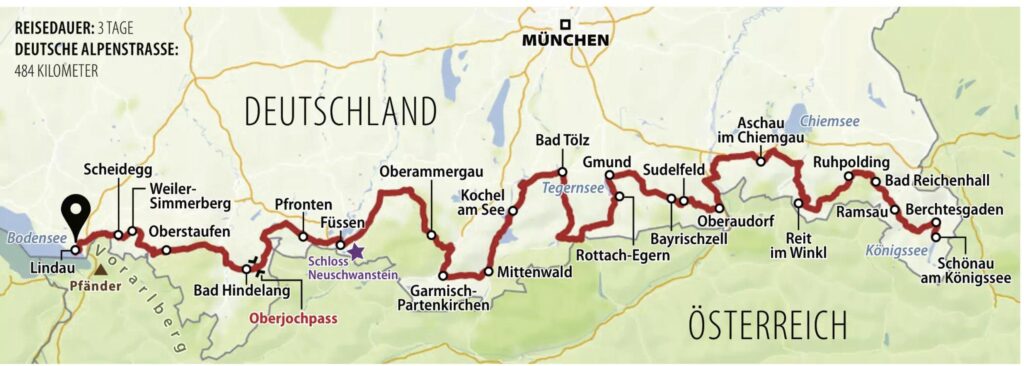
Optional stopover
During your Bavaria itinerary, you can choose to cut your route in half and stay overnight at Garmisch-Partenkirchen. Once here, you can explore the incredible Zugspitze, Germany’s highest mountain at 2,962 meters!
We didn’t stayover during our trip, but we did stop off at Zugspitze on the way. However, the weather was not on our side, with a particularly grey, cloudy and miserable day. The clouds made for some very dramatic views as they clung to the sides of the surrounding mountains, but a view of the summit was not on the cards. If you are planning a visit, make sure you check the weather forecast to make sure a stopover is worth your while.
At the Zugspitze summit on a clear day, you can see incredible views over the Alps – including 400 mountain peaks, across Germany, Austria, Italy and Switzerland! You can either reach the summit via cable car (the most popular route) or you can hike it, but that will take you about 2 days.
Day 5 – Berchtesgaden
You’re halfway through your Germany road trip itinerary! Welcome to Berchtesgaden, located in the Bavarian Alps on the Austrian border. During our trip across Southern Germany this was easily the place we were most excited about! It is also one of the most stunning locations we’ve visited, surrounded by dramatic mountains, and pretty emerald lakes. After a busy few days and a long day of driving, this is the perfect opportunity to have some down time and explore.
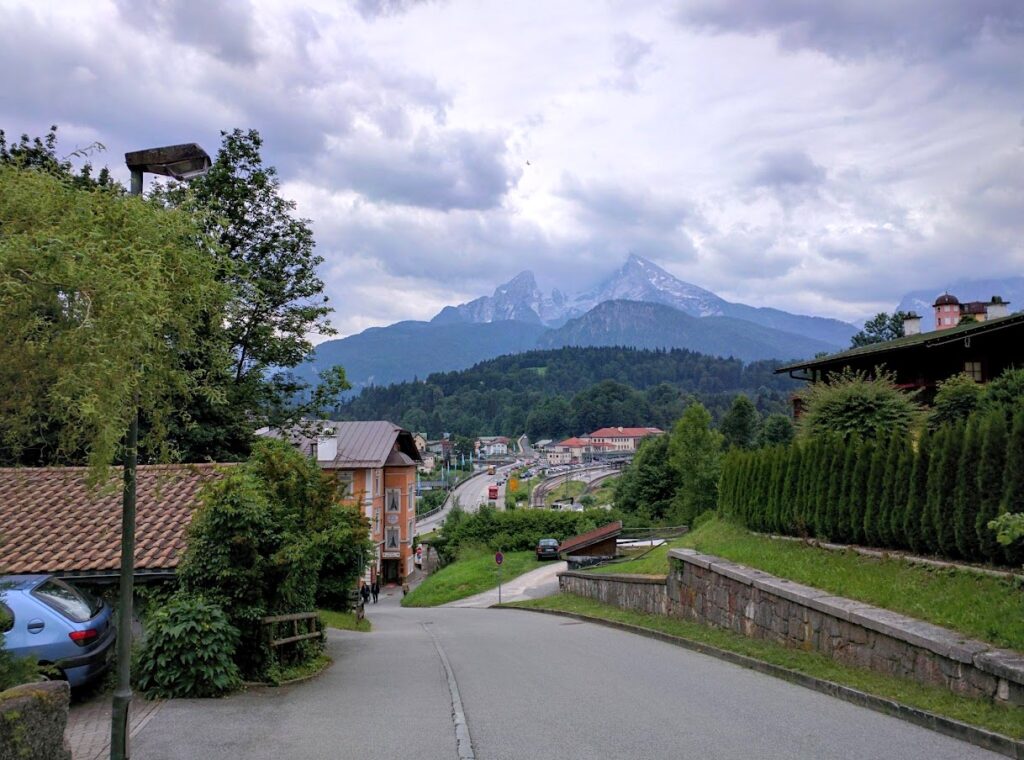
Things to see & do in Berchtesgaden
- Königssee
- Hitler’s Eagle’s Nest
- Jenner Mountain
- Salzbergwerk Salt Mine
- Marktplatz
Berchtesgaden has lots to offer, so while it’s not possible to squeeze in everything into your Bavaria itinerary, there are 2 main highlights which are easy to split over this time. These are exploring Lake Königssee and visiting Hitler’s Eagle’s Nest.
Lake Königssee
At 5 miles (8km) long and upto 1 mile (1.6km) wide, Königssee is well worth an explore! Situated at the centre of a valley and surrounded by mountains, in the heart of the Berchtesgaden National Park. It is not only Germany’s highest lake, but is also said to be the cleanest lake in Germany also.
Due to its steep mountain surroundings, the only way to explore the lake is by boat. There are regular electric tour boats, taking people up and down the lake. The route includes a return journey to and from St Bartholomä Church, which takes roughly 20 minutes. Due to the boats being electric, there are no noisy motors or engines to disrupt the tranquil setting as you jet along the lake. The guide on the boat will share some history, facts and general information about the lake and the area. When you reach the halfway point, a member of the crew will play a trumpet, which in turn is echoed back from the surrounding mountains.
Depending on when you go, it’s worth noting that Königssee can get very busy, particularly during the peak summer months. If you’d like to hop on the boat and explore the lake, then you can book your tickets online in advance. We’d recommend this over trying to purchase them on the day, when queues can be busy and long!
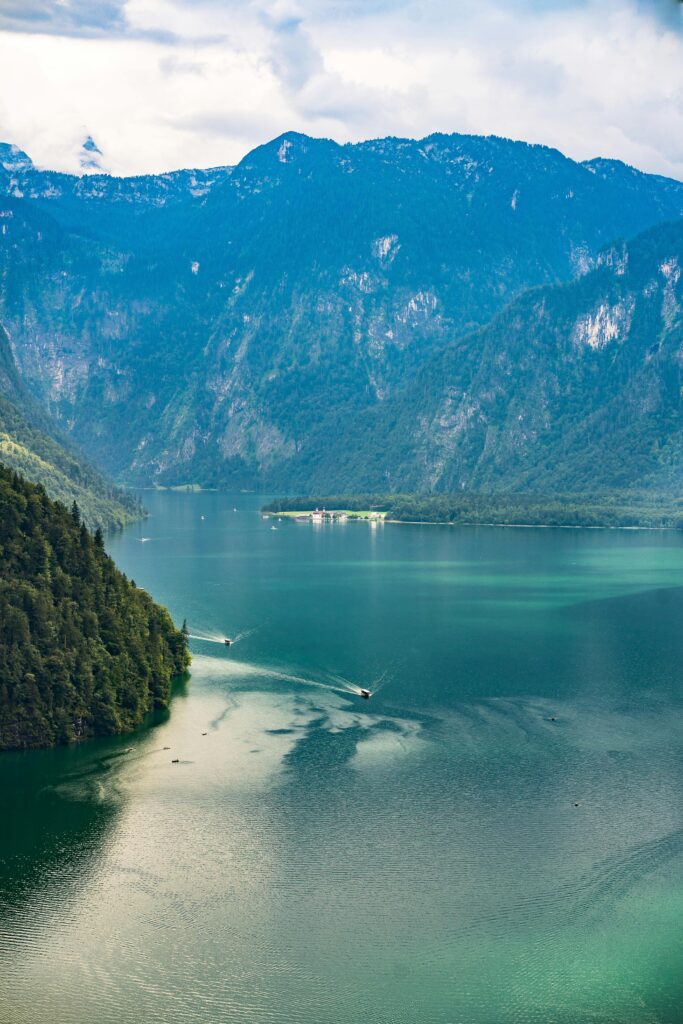
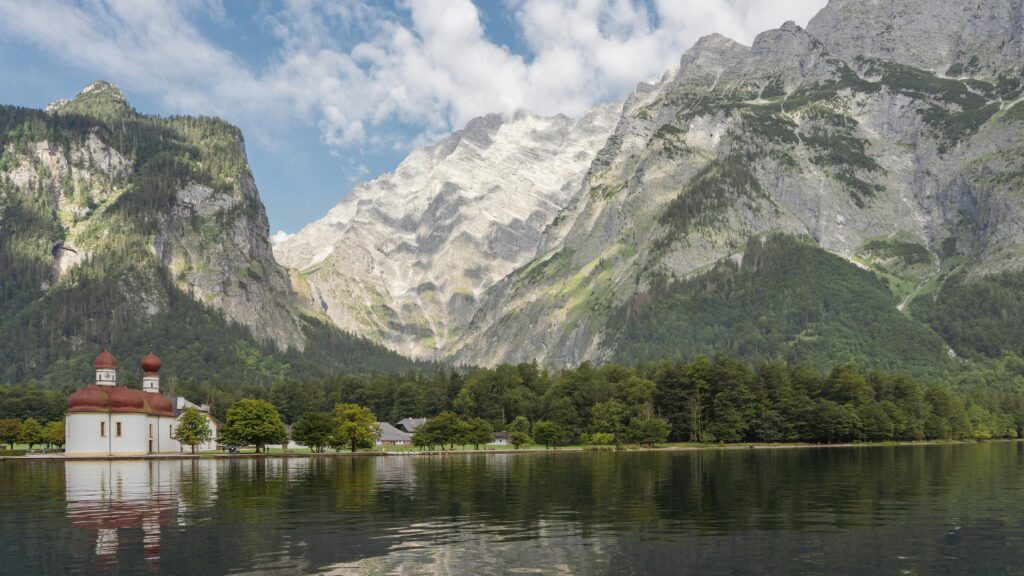
Catch the ferry to Bartholomä Church
The tour boat takes you directly to Bartholomä Church, a well-known pilgrimage church, with iconic red domes. This can initially be very busy, as most people stay within proximity to the church. Wander a little further and you will find some peaceful areas where you can steal some time to admire the views and explore the surroundings.
You can easily spend an hour here, depending how much of the hiking trails you want to explore. Another option is to hop on a second ferry and continue up the lake towards Salet. From here, a short 10 / 15 minute walk takes you to Obersee, another stunning lake, situated among Berchtesgaden’s impressive mountains. There are several hiking trails here and you can easily spend the whole day exploring. Not many tourists come as far as Salet, so you can enjoy the trails mostly to yourself, or even enjoy a swim in Obersee’s crystal clear waters. A route for the ferries is below, and a timetable for the ferry to the church.
After spending a day on the water exploring, there are loads of restaurants either in Berchtesgaden itself, or you can stay local to Königssee and try one of the many restaurants along the water’s edge.
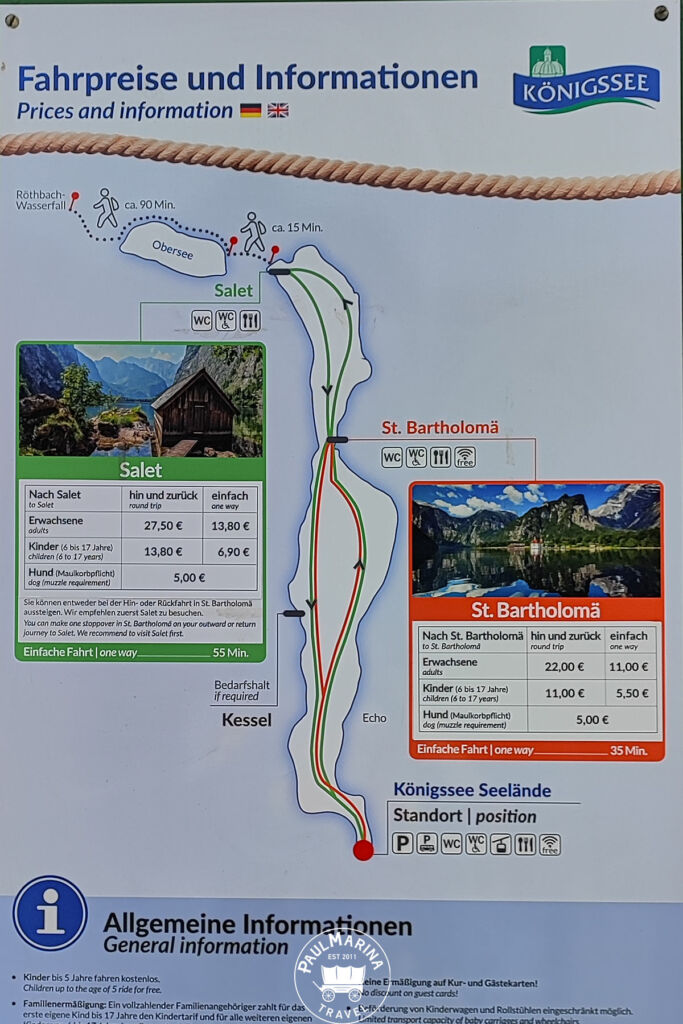
Day 6 – Hitler’s Eagles Nest
Next on your Bavaria itinerary, after a day chilling on the water, today is an epic opportunity to explore Hitler’s Eagle’s Nest (Kehlsteinhaus). Perched way up on the top of Mount Helstein, 1820m above sea level, the Eagle’s Nest was the place for state events and Government meetings during World War II. Today, it has been transformed as a restaurant, with incredible views over Berchtesgaden National Park and serves as a vital piece of history.
Your visit will start at the Dokumentation Obersalzberg Museum, featuring important exhibits and information about Hitler’s life and the events building up to the outbreak of World War II. In its day, Obersalzberg a huge compound of private buildings and extensive bunker systems, used by the Nazi’s. It was bombed to near non-existence during the war. However many ruins still remain and it is a fascinating part of the visit to the Eagle’s Nest, where you’ll learn much about the history, activities and plans that took place during the war.
Getting to the Eagle’s Nest
To get the Eagle’s Nest from Obersalzberg, you will need to catch the bus, which runs roughly every 25 minutes. Unless you choose to hike, this is your only option for getting there. The journey will take you on a very scenic, winding mountain pass. It’s about 7km total and rises to just over 800m. Grab a seat on the righthand side for stunning views across the National Park as you make your way up the mountain.
Once you’re off the bus, you’ll walk through a long tunnel, which Hitler and his guests would have used to access Kehlsteinhaus. At the end of the tunnel, is a brass elevator, which will take you up through the mountain, to the very top, where Kehlsteinhaus sits. While the venue is now a restaurant, there is some documentation in the sunroom where you can learn a little bit more. Generally it’s just a great opportunity to reflect on all that you’ve seen and learnt at Obersalzberg, explore the mountain and its gorgeous views, and try to imagine what Kehlsteinhaus was like during the war. It is a bizarre feeling to know you are walking the routes that Hitler and his party would have used all those decades ago. This really is a must see activity when you’re in the area.
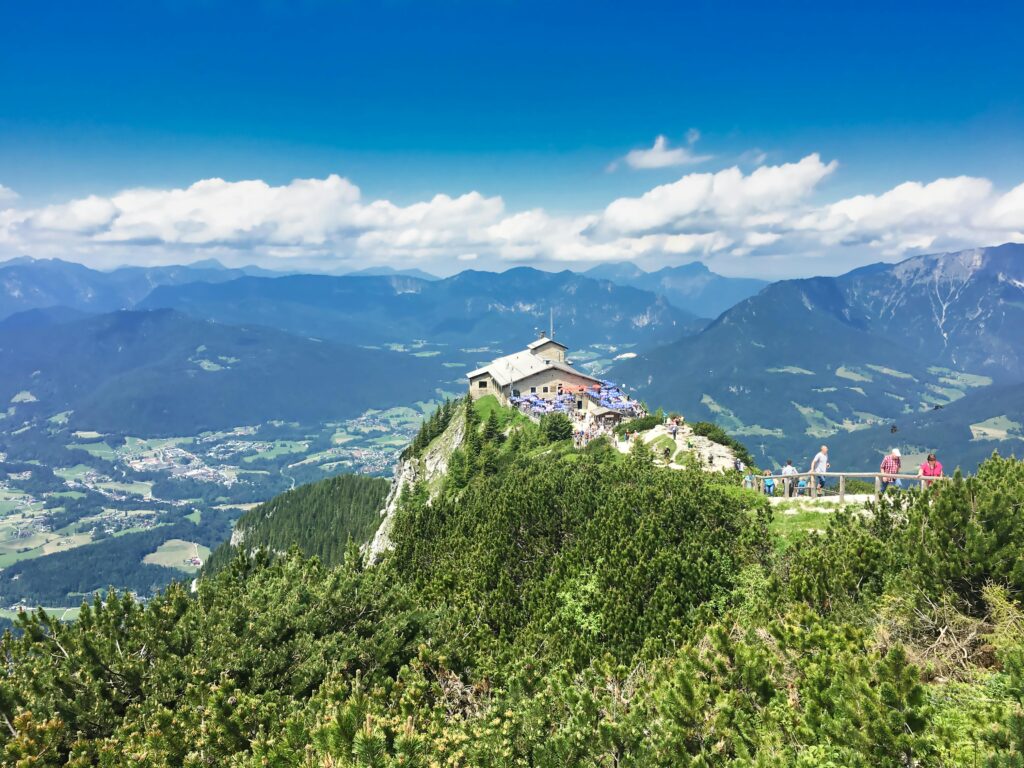
If you have time after your visit, you can choose to hike down the mountain to Obersalzberg, or catch the bus back. If you haven’t had enough summit views for one day, then close to Königssee, you can ride the gondola to the summit of Jenner Mountain for a different perspective of the National Park.
Day 7 – Drive to Munich (via Salzburg, Austria)
Drive time: 2 hours 20 minutes
Distance: 112 miles (180km)
After a couple of days off from the road, it’s time to pick up the last few days of your Germany road trip itinerary.
The Austrian city of Salzburg is just a 30 minute drive from Berchtesgaden, which makes for a great detour. We spent half a day in Salzburg before continuing the drive to Munich. While it’s nowhere near enough time to see everything, you can certainly see some of the main highlights and a taste to come back for more. A UNESCO World Heritage Site, the birthplace of Mozart, and a blend of German and Austrian culture, there is so much to see and love in Salzburg.
Driving in to Austria
If you’ve never driven in Austria before, one thing you must prep for is that you will need to purchase a vignette (a sticker which goes in your windscreen) to be able to drive on the motorways in Austria. This is a replacement for paying tolls on motorways, and is a mandatory requirement. Failing to do so can result in hefty fines!
The price of a vignette is less than €10 per day and can be purchased either at toll booths when you first enter the country or from petrol stations.
If this is also your first time driving through different countries in Europe, then it’s also worth noting that thanks to the Schengen Area, which guarantees free movement to EU Citizens across European borders, you do not need to queue up for lengthy security and passport checks (but keep your passport handy just in case). You will simply see a European sign with the country written in the middle of it and that will be your first notification that you have crossed the border! Depending on your route, you may have a border check, but it’s quite hit and miss. We drove into Zurich from Germany and we were asked to show our passports (but another time driving into Switzerland there was no-one there and the barrier was up). Equally, driving into Austria, there wasn’t a barrier and no-one asked to see passports either.
Things to see & do in Salzburg
- Fortress Hohensalzburg
- Salzburger Altstadt (the old town)
- Salzburg Cathedral
- Rathaus (town hall)
- Salzach River
- Makarsteg Bridge
- Red Bull Hangar-7
Have a leisurely explore around Salzburg. Walk along the river Salzach and cross the Makarsteg Bridge (Love Lock Bridge). Ride the funicular to the top of Hohensalzburg Fortress and explore the site, which also offers beautful views over the city below you. The old town and Salzburg Cathedral are also worth a visit. A little outside of the city a short 15 minute drive away is the Red Bull Hangar-7. This has a fantastic collection of Red Bull’s history, featuring everything from their F1 cars to planes, spacecrafts and other flying machines. It’s a great museum and you can wander around at your own pace, before rounding off your day with the final leg of your Germany road trip itinerary as you make your way to Munich.
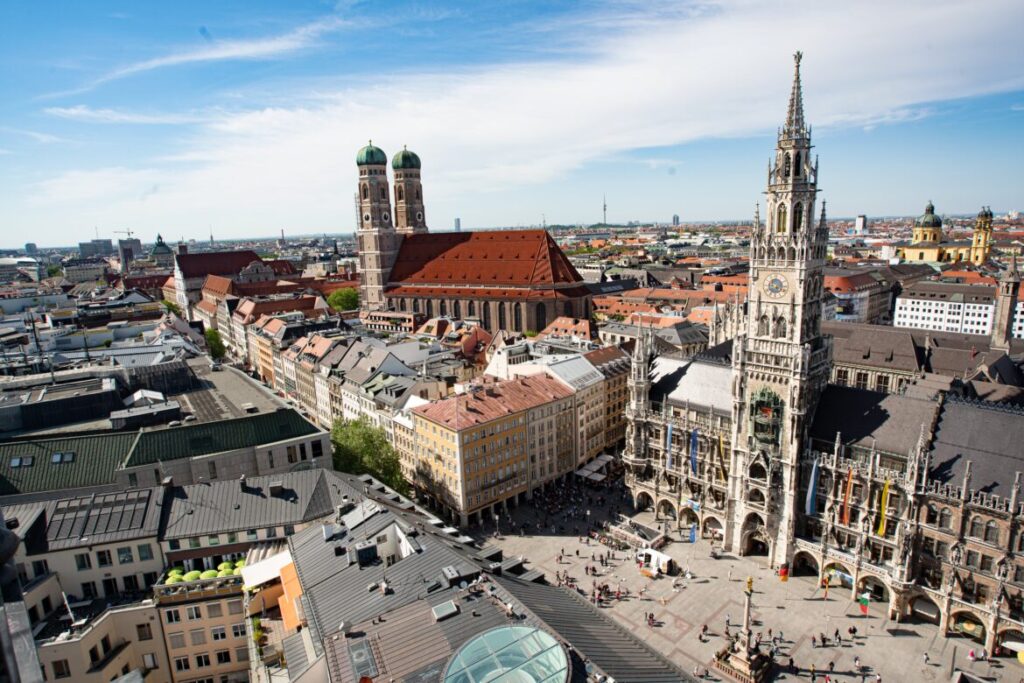
Day 8 – Munich
Your Bavaria itinerary culminates in Munich – the capital of Bavaria! Munich is the perfect way to wind-up your Bavaria road trip. It’s a city full of rich history, architecture, beer halls, beautiful scenic parks and famous for Oktoberfest. Munich was one of our favourite cities we visited during our road trip.
Getting around Munich is also super easy. While a fairly major city, it certainly feels smaller than other large cities and much of the main sights, attractions and parks can be easily explored on foot.
Things to see & do in Munich
- Marienplatz old town
- Neues Rathaus (new town hall)
- Enjoy Munich’s beer gardens
- Explore the English Garden
- BMW Museum
- St Peter’s Church and the Bell Tower
- Frauenkirche
- Experience a Bavarian Beer Hall
Start your day exploring the old town, with its stunning Neo-gothic architecture. Straight away you’ll notice Neues Rathaus (new town hall), with it’s stunning design and detail in the heart of the old town. It’s also famed for its glockenspiel mechanical clock, which chimes everyday at 11am and 12pm, re-enacting scenes from Munich’s history. The display is quite something, with everyone in the old town gathering to watch the show.
The Town Hall also features an 85m tower, which you can get to the top of via an elevator, with fab views across the city. However, if it’s views you want, then there’s no better city centre lookout than St Peter’s Church Bell Tower. Situated right in the heart of Marienplatz, the Bell Tower offers incredible views directly over the old town, including a stunning view looking directly at the town hall, and also the beautiful Frauenkirche Church, with its iconic twin towers and red roof.
Finish up your day with a little more exploring by visiting the lovely English Garten, a large park, stretching from the city centre to the northern limits of Munich. It includes a large lake teeming with wildlife and you can ride pedalo boats on it. There’s also a scenic beer garden and several cute cafes and restaurants, plus miles of peaceful scenic walks. It’s a great place to kick back, reflect on your travels so far and people watch.
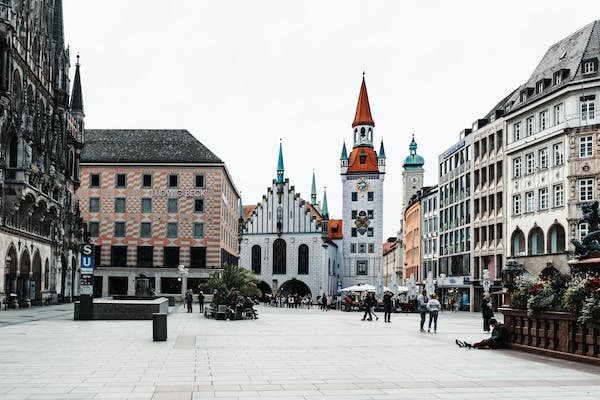
Day 9 – Munich
Spend today a little further afield, exploring the BMW Museum just outside the city centre. There’s also Olympiapark, which features the tall Olympic Tower, a 291m tower, with an observation deck at 190m offering views far and wide. There’s also an exhibition in the tower commemorating the 50th anniversary of the tower. Elsewhere in Olympic Park, you can visit the stadium, built for the 1972 Summer Olympics. The grounds within Olympic Park are expansive and you can easily spend a day here touring the sights and taking in the scenery.
After a long day on your feet, you can rest up and refresh, by experiencing Munich’s famed beer halls – of which there is non other more famous than Hofbräuhaus Brewery. We came here for Oli’s birthday and it was the best way to celebrate! The beerhouse is filled with huge, long tables and benches. Pull up a seat and get chatting to everyone on your table. We can be socially awkward at the best of times, but this was a fab experience and we quickly made friends others on our table, sharing experiences and where we were all travelling to next. The atmosphere is amazing and was genuinely a highlight of our visit to Munich. They also had a live Oompah band, and for those who don’t like beer (like me) they also sell wine (although this is only by the bottle, and kept in the cellar, so you may have to wait a while). You will easily spend your evening here, drinking in the atmosphere and whatever else you choose to drink!
Oktoberfest
If you’re also keen to visit Munich during Oktoberfest, then below are the dates you need to be aware of. It’s worth booking in advance as accommodation gets booked quickly. Prices can also soar, as this is a peak time to visit. Alternatively, if you also want to avoid this time of year for that very reason, then these are the dates to look out for. The official Oktoberfest website can be found here.
- Oktoberfest 2024: September 21 – October 6
- Oktoberfest 2025: September 20 – October 5
- Oktoberfest 2026: September 19 – October 4
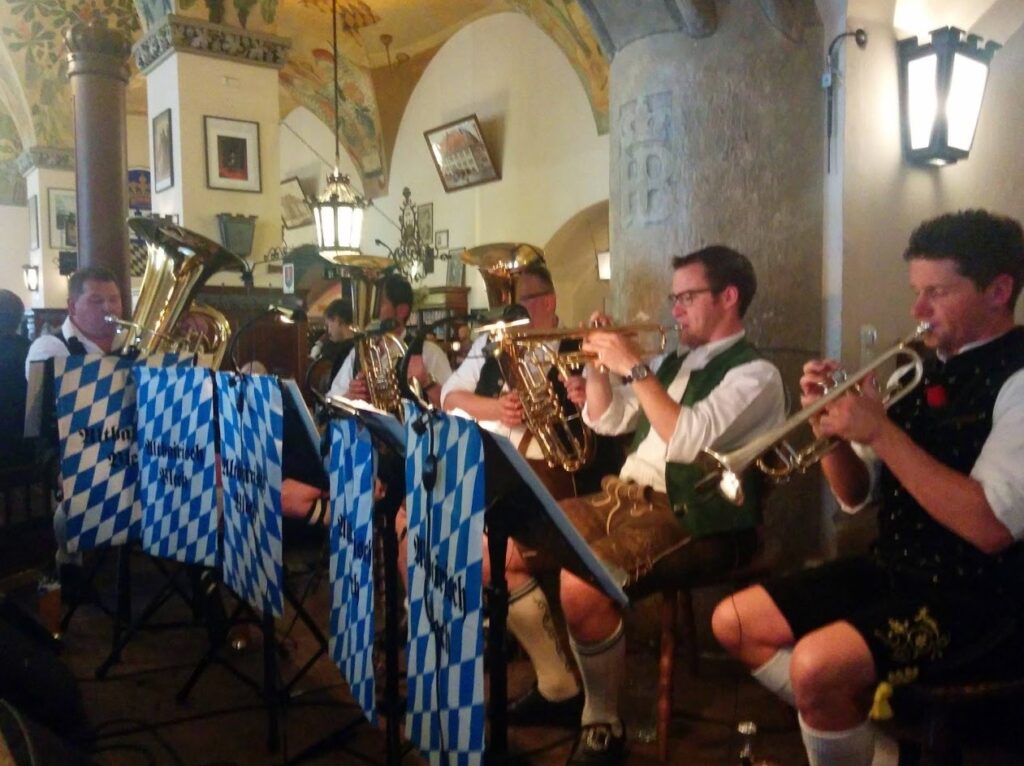
Day 10 – Final day in Munich or optional stopover
Depending on travel plans, you can spend your last few hours exploring the rest of Munich. Alternatively, if you have an early flight, grab a filling breakfast to help soak up the previous night’s alcohol! If you have more time then there is an optional stopover you can add to your Germany road trip itinerary.
Just a short 30 minute drive from Munich, you can take a day trip out of the city to visit Dachau Concentration Camp. I will add, we never visited this one ourselves, but we have been to Sachsenhausen Concentration Camp in Berlin, plus Auschwitz in Poland. It sounds like a strange thing to say, but visiting a camp is a great day out. It’s always incredibly informative, respectful, and humbling. You may not be super history buffs, and your time in Berchtesgaden may feel like enough WWII history for you, but these concentration camps serve as painful reminders of what has been and what must never be repeated again. If you haven’t visited one of these sights yet, they are incredibly sobering experiences and we personally think should be on everyone’s list to visit at some point, particularly as this piece of history continues to get further away from generations over time.
Further inspiration?
If you’d like to see a little more of what a road trip across Germany looks like, or for more Bavaria itinerary ideas, check out our video with highlights from our own trip! This includes shots from Belgium, through The Black Forest and Bavaria, and up to Frankfurt, Dusseldorf and Cologne.
Bavaria Itinerary Questions?
We hope you enjoyed our post and found this Germany road trip itinerary helpful! Bavaria truly is a stunning part of Germany and has so much to offer. Whether you’re interested in scenery, hiking, food, culture or history. It really does have it all, and this suggested Bavaria itinerary only scratches the surface! There is so much more to see and do, so if you have any questions, or any tips you’d like to share for future planners, please share them in the comments below, we’d love to hear from you!
If you found our blog helpful, check out our Insta @welovetravel.in – if you give us a follow feel free to drop us a message and say hello 👋
For more Germany travel inspiration check out our other guides and Trip Reports below:

